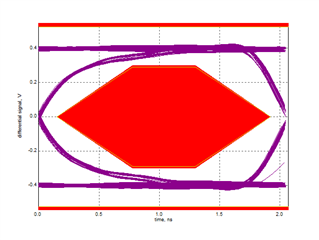Hi There:
I have an application with TS3DS10224 below.USB2.0 signal from CPU to MUX pin INB+/-, after passing through MUX, connect to the USB port.
we couldn't pass the eye-diagram test. For tracing the root cause, We probe the INB+/- side and got the distorted eye diagram below.
We tried to remove MUX and short the empty section, then the eye diagram can pass.
So I doubt the MUX is impedance mismatch with my circuit.
Could I know the load Impedance of TS3DS10224?
And should I add some resistor for Impedance matching?
(My net impedance is 90ohm Zdiff, trace length from CPU to MUX is 2900 mil)
thanks.







